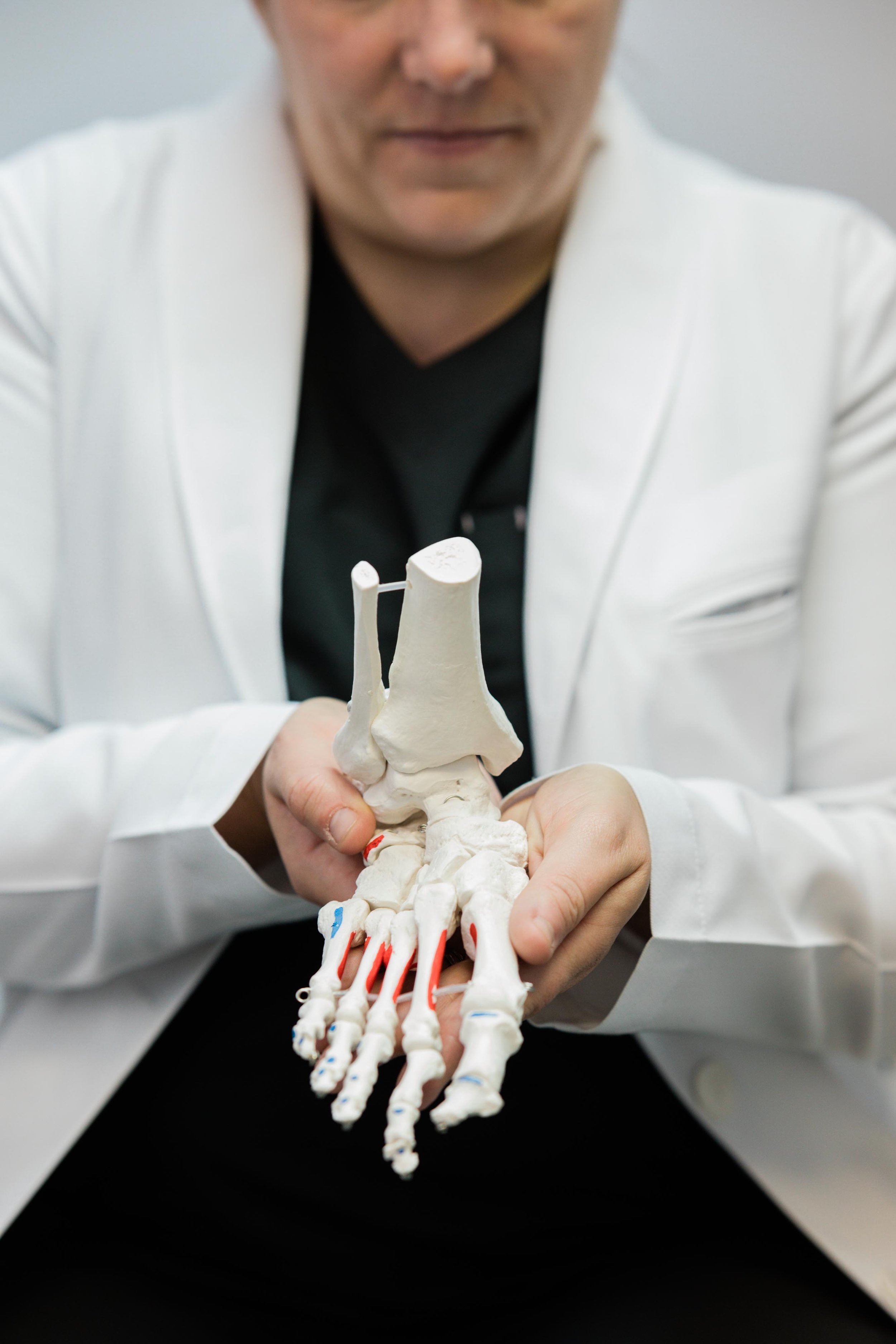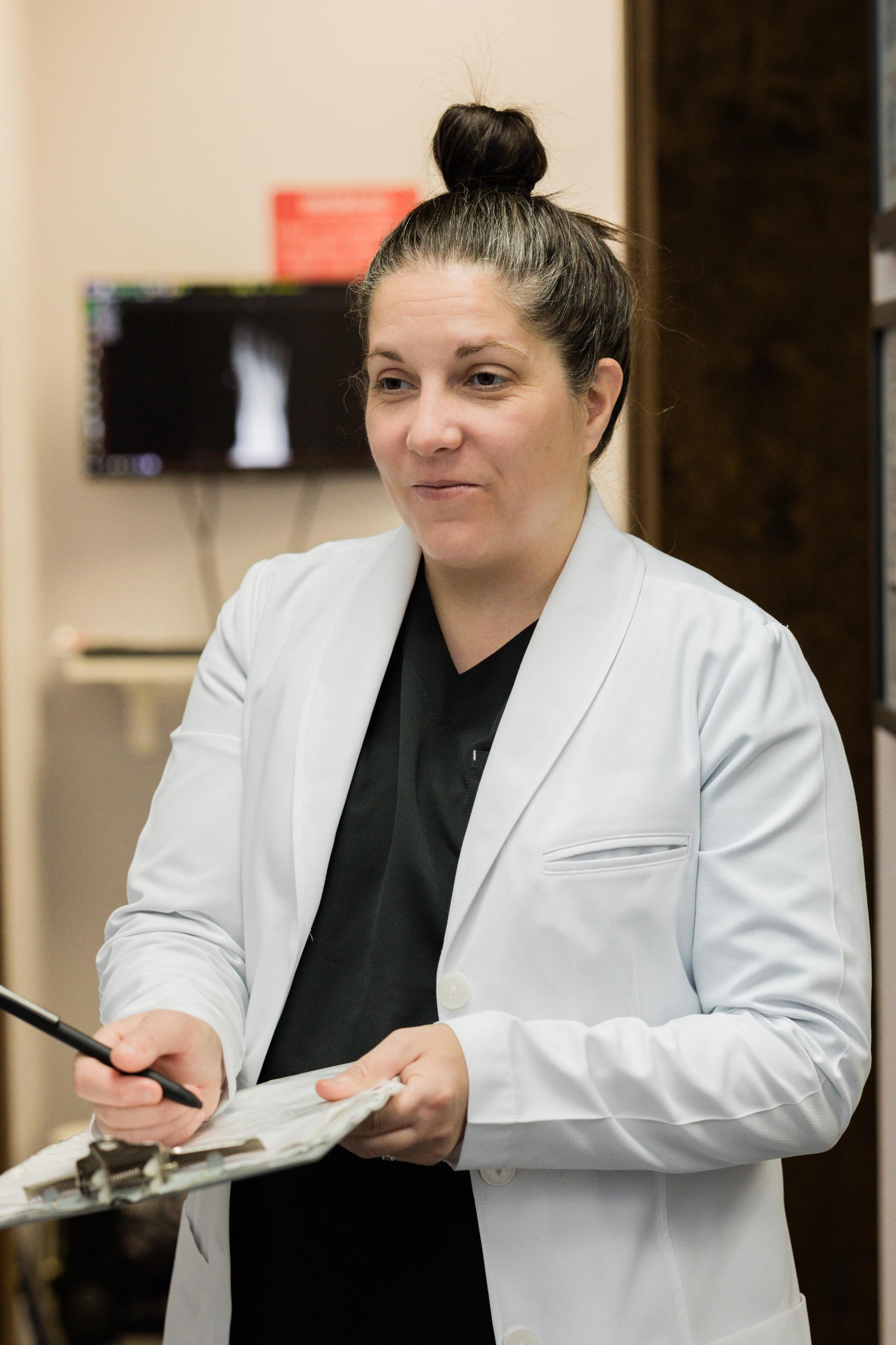What is a Podiatrist and Why Do You Need One?
You’re a busy, active professional. That’s why you’ve chosen to make your home in one of our country’s most dynamic urban locales.
From the food to the sports, the music scene to the thriving business community—Chicago is an ideal place for forward-thinking folks to grow and thrive, personally and professionally.
But when you spend your days pounding the pavement, you may find your feet and ankles pay the price of your hectic, on-the-go lifestyle.
If you experience pain or other issues with your feet, ankles, and lower legs, finding a podiatrist in Chicago is a must to ensure you can keep up your life’s pace.
When you’re young and healthy, a podiatrist may not be on your shortlist of doctors you need to see. At least, they aren’t until you experience the issues that they’re uniquely qualified to address and treat.
When you’re struggling with foot pain, ankle strain, or other issues that impact your lower body’s strength, mobility, and ability to function—you need a podiatrist to help you sort things out.
The right podiatrist can literally help you get back on your feet again (see what we did there?).
But what exactly does a podiatrist do? What issues and conditions are they qualified to treat? And how can they support you to live your best, healthiest life?
This article will explore the many facets of podiatry to help you understand the value of this important branch of healthcare.
We’ll even take a look at what qualifications podiatrists receive—so you can select the right podiatrist for you with confidence in their skillset and certifications.
Let’s dive right in.
What are podiatrists and what do they treat?
In a nutshell—a podiatrist is a foot doctor.
They’re trained to assess and treat issues that impact your toes, feet, ankles, and the connecting parts of your legs.
Did you know your feet contain more than 20 different bones? It’s true! And those bones not only take a pounding (literally!), but they must work together in an intricate, coordinated dance to keep you moving forward without pain or discomfort.
Your feet also have an impressive network of ligaments, tendons, joints, and muscles—all of which can experience pain and injury that can limit your mobility and slow you down.
In short—your feet have a big job!
Many podiatrists are also podiatric surgeons, which means they can perform surgical procedures to address conditions and injuries of the toes, feet, and ankles when necessary.
The official title given to licensed podiatrists is Doctor of Podiatric Medicine. This title is often abbreviated as DPM.
You may notice when you’re searching for a podiatrist in your area that most use this abbreviation after their name to indicate their credentials, much like MDs or other types of doctors do.
Now that you’re more clear on what type of doctor a podiatrist is, let’s explore some of the specific issues and concerns they’re trained to address and treat.
Why should you see a podiatrist?
You care about your feet, right? After all, they’re how you get around.
Your friendly neighborhood podiatrist shares your concerns—and they know how to help.
They also want to ensure the well-being of your ankles, toes, and lower legs, because they know these systems are the key to your mobility, balance, and overall health and wellness.
You might be surprised at how many health issues show up in these body parts.
Just some of the issues podiatrists and podiatric medicine can help you address include—
Toenail fungus and ingrown toenails—your podiatrist can help you treat and remove the root causes of foot and nail fungus so you can proudly display your feet again. They can also help you banish the discomfort and irritation of ingrown toenails.
Flat feet and arch support—many folks experience pain and discomfort because of their arches. Your podiatrist can help you live supported and pain-free with a range of treatment options. From custom orthotics to podiatry recommended shoes, your podiatrist can help ensure your arches get the love they deserve.
Common foot issues like—
Corns
Calluses
Bunions
Plantar warts
Foot and ankle pain—nothing can derail your day like foot and ankle pain. Your podiatrist will help you uncover the source of your issues and develop a treatment plan to address your needs—so you can get back up to speed.
Foot and ankle numbness and tingling—these symptoms can be a sign something bigger is afoot. Get the info you need to make informed decisions about your health by letting your podiatrist assess the causes of your reduced lower extremity sensation.
Foot and ankle wounds and infections—these issues can not only make getting around difficult and painful—they can also lead to more serious issues if left untreated. Your podiatrist can help you assess and treat any infections or wounds on your feet or ankles, so they can heal fully and not become worse.
Without prompt, proper diagnosis and treatment, the above issues can seriously impact your overall health and well-being.
That’s why it’s vital to reach out to a podiatrist if you have any concerns or questions about your toes, feet, ankles, heels, or lower legs.
Your podiatrist can help you address these issues and create a customized plan to treat them—so you can get back on your feet.
Podiatrists can also order or perform X-rays and other imaging tests to get to the root cause of any foot and ankle problems you’re experiencing. They can order lab work, prescribe medication, and even refer you to a physical or occupational therapist if needed.
If surgery is warranted, your podiatrist can often perform your procedure themselves. Your podiatrist is highly skilled at assessing your surgical needs and performing the appropriate procedures. If you require a surgical intervention that’s out of their scope, they can refer you to a qualified specialist as needed.
Podiatrists also support those with chronic health conditions that are known to cause issues with the feet and ankles. This includes helping people with diabetes, circulation issues, and weakened immune systems.
Let’s take a look at the training podiatrists receive, so you can learn why they’re uniquely prepared to treat your precious feet.
What training do podiatrists receive?
Just like other types of physicians, podiatrists must attend medical school and complete a residency in order to practice.
In some cases, they may also complete a fellowship training following their residency.
They must also obtain and maintain a license to practice in the state they choose to work in. This license must be renewed regularly, which involves the completion of continuing education and adherence to ethical standards of practice.
So, when you’re searching for a podiatrist, be sure you check their credentials and certifications so you know they’re legit and qualified to offer you the care and support you need for your toes, feet, ankles, and legs.
Podiatrists in this country complete the following in order to practice—
Four years of undergraduate studies
Four years of podiatry school
Three years of residency with surgical training
Most podiatrists also obtain and maintain their board certification. While this isn’t technically required in order to practice, it’s an additional step many podiatrists opt to take, to offer their clients the assurance that they're tip-top in their field. This can be a great way to search for a podiatrist in your area, to ensure you’re connecting with top-quality providers.
In short—podiatrists are extremely well-prepared in their area of speciality by the time they’re qualified to treat your feet.
Your podiatrist will be happy to fill you in on their skills and schooling—because they’ve worked hard to get where they are, and they want to make sure they’re the right doc to take care of you.
Some podiatrists choose to specialize, niching down their skill set even further to focus on helping a specific type of patient. Podiatric specialties include:
Sports medicine
Diabetic foot care
Pediatrics
Wound care
And reconstructive surgery
As undergrads, many future podiatrists opt to pursue a science-heavy curriculum to prepare them for their specialized schooling to come. Many students who hope to become podiatrists make sure their course loads include lots of chemistry, biology, and physics classes.
This foundation helps prepare them for their four years of podiatry school. This is where they dive deep into learning the anatomy and physiology of the feet, ankles, and legs and learn how injuries and illnesses can impact their ability to function.
They also learn how to diagnose and treat issues of the feet and ankles. This includes how to perform necessary surgeries on these body parts.
Now that you have a sense of what goes into becoming a podiatrist, let’s take a look at what distinguishes them from other types of doctors.
How are podiatrists different from other types of doctors?
Many doctors opt to specialize. This allows them to treat a specific type of patient, condition, or area of the body.
Podiatrists understand the value of foot and ankle health and choose to focus on uplifting the health and wellness of these vital lower body structures.
Like any doctor, podiatrists have extensive education and knowledge to understand how the entire body and its systems work together to keep you functioning at your best.
They know that your feet and ankles are the foundation of your mobility, health, and wellness.
When you’re dealing with intricate, coordinated systems, like those of your feet and ankles—it helps to have a specialist who’s focused on deeply understanding these body parts and how they work.
After all—you wouldn’t choose a baker to work on your car, right? And a mechanic probably wouldn’t be your first choice to prepare your taxes.
Just like you’d choose a plumber to fix your pipes and an accountant to balance your books—you want a podiatrist to diagnose and treat any issues with your ankles and feet.
Podiatry is so specialized that podiatrists don’t attend traditional medical schools. Instead, podiatrists specialize from the get-go and attend medical schools that are specifically dedicated to educating and training them in podiatric medicine.
They also have their own distinct professional associations. That’s why you’ll see the abbreviation DPM after their title, as opposed to MD.
At present, there are less than ten podiatry programs in the country that are accredited by the American Podiatric Medical Association. This means competition to be a podiatrist in the US can be fierce, and only the best of the best make the cut.
Many people feel confused about the difference between podiatrists and orthopedists. While it’s true these two medical specialties have some overlap, they also have key distinctions that can help you select the right provider for your health and wellness needs.
Whereas podiatrists specialize in assessing and treating issues with the feet and ankles, orthopedists are more general specialists in the body’s musculoskeletal system. This means they also treat lower body issues with your knees, hips, and spine.
Now, while it’s true some orthopedists opt to specialize in foot and ankle issues, they function primarily as surgeons. Podiatrists, on the other hand, can bring a wide range of treatment options to the table when it comes to addressing conditions impacting your feet and ankles.
Both podiatrists and orthopedists can treat foot and ankle issues when they arise, but it’s generally considered best to seek out the support of a podiatrist for issues with your feet and ankles. That’s because podiatrists are singularly focused on the issues that impact these parts of the body.
Podiatrists are specialized in the parts of the body they treat, but this focus allows them to go wide in the different medical options they offer to treat issues with the feet and ankles. In creating your ideal, comprehensive treatment plan, your podiatrist can draw from medical approaches like orthopedics, dermatology, neuology, and rheumatology.
When your feet and ankle health is on the line, it’s always wise to seek out a specialist who has spent their professional life focused on learning all there is to know about these intricate systems and knows how to heal them and help them work their best.
How can I find a podiatrist in Chicago?
When you’re searching for a podiatrist in Chicago, you want to connect with someone who understands your busy lifestyle and unique needs.
Because you’re not just looking for any foot doctor in Chicago—you’re seeking your Cinderella glass slipper moment.
After all, you deserve a podiatrist who gets you, and can help you get where you’re going, pain-free.
If you're living with foot pain, heel pain, pain while walking, pain while running, or pain that’s hindering your ability to live your life and go about your daily routine, you need a podiatry specialist who can help you find the answers you're seeking to overcome your pain and its impact on your life.
When you’re searching for a Chicago area podiatrist online, you want to know you’re connecting with the right specialist to not only address your needs, but listen to you, take the time to understand your lifestyle and collaborate with you to develop a treatment plan that’s designed just for you.
It may seem like a tall order—more complex than your favorite Starbucks pick-me-up—but, thankfully, finding the perfect podiatrist in Chicago doesn’t have to be a frustrating, time-consuming ordeal.
City Step Podiatry was designed with you in mind.
Our bright, modern, state-of-the-art clinic is here to serve the podiatry needs of busy, active professionals like you—who live and work in and around downtown Chicago.
Because you’re always on the go—and you need to stay that way. City Step Podiatry will help you get back to feeling your best, without missing a step.
Our warm, welcoming office and convenient downtown Chicago location mean you’ll feel comfortable when you visit us and you’ll love the convenience of being able to fit in an appointment with us before or after work, on your lunch break, or anytime your feet and ankles need some extra TLC.
We’ll take the time to explain our findings and involve you in developing the best course of treatment for you. Because Dr. Alison Young, DPM understands what it means to be a busy professional who’s proud to call the Windy City home—she is one, herself!
She created City Step Podiatry to serve the unique needs of dynamic Chicago residents like you—who need great care from providers who respect that you deserve easy access to top-quality, personalized health and wellness services.
Because the best approach is never to ignore foot and ankle pain, injuries, or swelling. Get the expert support you need in a convenient location that caters to your lifestyle.
Don’t wait for the specialized foot and ankle care you need—stop by and see us in the office, give us a call, or shoot us an email. We look forward to connecting with you to address all your podiatry needs in Chicago!
City Step Podiatry is here for you! Reach out today to schedule your visit and treat your feet to the care they deserve.












